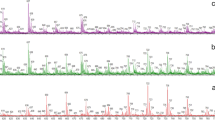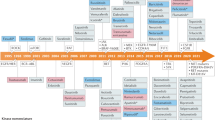Abstract
Protein kinases are attractive therapeutic targets, but their high sequence and structural conservation complicates the development of specific inhibitors. We recently identified, in a DNA-templated macrocycle library, inhibitors with unusually high selectivity among Src-family kinases. Starting from these compounds, we developed and characterized in molecular detail potent macrocyclic inhibitors of Src kinase and its cancer-associated 'gatekeeper' mutant. We solved two cocrystal structures of macrocycles bound to Src kinase. These structures reveal the molecular basis of the combined ATP- and substrate peptide–competitive inhibitory mechanism and the remarkable kinase specificity of the compounds. The most potent compounds inhibit Src activity in cultured mammalian cells. Our work establishes that macrocycles can inhibit protein kinases through a bisubstrate-competitive mechanism with high potency and exceptional specificity, reveals the precise molecular basis for their desirable properties and provides new insights into the development of Src-specific inhibitors with potential therapeutic relevance.
This is a preview of subscription content, access via your institution
Access options
Subscribe to this journal
Receive 12 print issues and online access
$259.00 per year
only $21.58 per issue
Buy this article
- Purchase on Springer Link
- Instant access to full article PDF
Prices may be subject to local taxes which are calculated during checkout






Similar content being viewed by others
References
Cohen, P. Protein kinases—the major drug targets of the twenty-first century? Nat. Rev. Drug Discov. 1, 309–315 (2002).
Manning, G., Whyte, D.B., Martinez, R., Hunter, T. & Sudarsanam, S. The protein kinase complement of the human genome. Science 298, 1912–1934 (2002).
Cools, J. et al. PKC412 overcomes resistance to imatinib in a murine model of FIP1L1-PDGFRα-induced myeloproliferative disease. Cancer Cell 3, 459–469 (2003).
Bikker, J.A., Brooijmans, N., Wissner, A. & Mansour, T.S. Kinase domain mutations in cancer: implications for small molecule drug design strategies. J. Med. Chem. 52, 1493–1509 (2009).
Capdeville, R., Buchdunger, E., Zimmermann, J. & Matter, A. Glivec (STI571, imatinib), a rationally developed, targeted anticancer drug. Nat. Rev. Drug Discov. 1, 493–502 (2002).
Zhang, J., Yang, P.L. & Gray, N.S. Targeting cancer with small molecule kinase inhibitors. Nat. Rev. Cancer 9, 28–39 (2009).
Adrián, F.J. et al. Allosteric inhibitors of Bcr-abl-dependent cell proliferation. Nat. Chem. Biol. 2, 95–102 (2006).
Ohren, J.F. et al. Structures of human MAP kinase kinase 1 (MEK1) and MEK2 describe novel noncompetitive kinase inhibition. Nat. Struct. Mol. Biol. 11, 1192–1197 (2004).
Shan, Y. et al. How does a drug molecule find its target binding site? J. Am. Chem. Soc. 133, 9181–9183 (2011).
Levitzki, A. Protein tyrosine kinase inhibitors as novel therapeutic agents. Pharmacol. Ther. 82, 231–239 (1999).
Gazit, A., Yaish, P., Gilon, C. & Levitzki, A. Tyrphostins I: synthesis and biological activity of protein tyrosine kinase inhibitors. J. Med. Chem. 32, 2344–2352 (1989).
Krishnamurty, R. & Maly, D.J. Biochemical mechanisms of resistance to small-molecule protein kinase inhibitors. ACS Chem. Biol. 5, 121–138 (2010).
Soverini, S. et al. Contribution of ABL kinase domain mutations to imatinib resistance in different subsets of Philadelphia-positive patients: by the GIMEMA working party on Chronic Myeloid Leukemia. Clin. Cancer Res. 12, 7374–7379 (2006).
Azam, M., Seeliger, M.A., Gray, N.S., Kuriyan, J. & Daley, G.Q. Activation of tyrosine kinases by mutation of the gatekeeper threonine. Nat. Struct. Mol. Biol. 15, 1109–1118 (2008).
Gartner, Z.J. & Liu, D.R. The generality of DNA-templated synthesis as a basis for evolving non-natural small molecules. J. Am. Chem. Soc. 123, 6961–6963 (2001).
Gartner, Z.J. et al. DNA-templated organic synthesis and selection of a library of macrocycles. Science 305, 1601–1605 (2004).
Li, X. & Liu, D.R. DNA-templated organic synthesis: nature's strategy for controlling chemical reactivity applied to synthetic molecules. Angew. Chem. Int. Edn Engl. 43, 4848–4870 (2004).
Doyon, J.B., Snyder, T.M. & Liu, D.R. Highly sensitive in vitro selections for DNA-linked synthetic small molecules with protein binding affinity and specificity. J. Am. Chem. Soc. 125, 12372–12373 (2003).
Kleiner, R.E., Dumelin, C.E. & Liu, D.R. Small-molecule discovery from DNA-encoded chemical libraries. Chem. Soc. Rev. 40, 5707–5717 (2011).
Tse, B.N., Snyder, T.M., Shen, Y. & Liu, D.R. Translation of DNA into a library of 13,000 synthetic small-molecule macrocycles suitable for in vitro selection. J. Am. Chem. Soc. 130, 15611–15626 (2008).
Kleiner, R.E., Dumelin, C.E., Tiu, G.C., Sakurai, K. & Liu, D.R. In vitro selection of a DNA-templated small-molecule library reveals a class of macrocyclic kinase inhibitors. J. Am. Chem. Soc. 132, 11779–11791 (2010).
Knight, Z.A. & Shokat, K.M. Features of selective kinase inhibitors. Chem. Biol. 12, 621–637 (2005).
Biron, E., Chatterjee, J. & Kessler, H. Optimized selective N-methylation of peptides on solid support. J. Pept. Sci. 12, 213–219 (2006).
Abbott, L. et al. Discovery of thienopyridines as Src-family selective Lck inhibitors. Bioorg. Med. Chem. Lett. 17, 1167–1171 (2007).
Burchat, A.F. et al. Pyrazolo[3,4-d]pyrimidines containing an extended 3-substituent as potent inhibitors of Lck—a selectivity insight. Bioorg. Med. Chem. Lett. 12, 1687–1690 (2002).
Maly, D.J., Choong, I.C. & Ellman, J.A. Combinatorial target-guided ligand assembly: identification of potent subtype-selective c-Src inhibitors. Proc. Natl. Acad. Sci. USA 97, 2419–2424 (2000).
Bamborough, P., Drewry, D., Harper, G., Smith, G.K. & Schneider, K. Assessment of chemical coverage of kinome space and its implications for kinase drug discovery. J. Med. Chem. 51, 7898–7914 (2008).
Karaman, M.W. et al. A quantitative analysis of kinase inhibitor selectivity. Nat. Biotechnol. 26, 127–132 (2008).
Levinson, N.M. et al. A Src-like inactive conformation in the abl tyrosine kinase domain. PLoS Biol. 4, e144 (2006).
Hubbard, S.R. Crystal structure of the activated insulin receptor tyrosine kinase in complex with peptide substrate and ATP analog. EMBO J. 16, 5572–5581 (1997).
Barouch-Bentov, R. et al. A conserved salt bridge in the G loop of multiple protein kinases is important for catalysis and for in vivo Lyn function. Mol. Cell 33, 43–52 (2009).
Laszlo, G.S. & Cooper, J.A. Restriction of Src activity by Cullin-5. Curr. Biol. 19, 157–162 (2009).
Xu, W., Harrison, S.C. & Eck, M.J. Three-dimensional structure of the tyrosine kinase c-Src. Nature 385, 595–602 (1997).
Sicheri, F., Moarefi, I. & Kuriyan, J. Crystal structure of the Src family tyrosine kinase Hck. Nature 385, 602–609 (1997).
Seeliger, M.A. et al. High yield bacterial expression of active c-Abl and c-Src tyrosine kinases. Protein Sci. 14, 3135–3139 (2005).
Seeliger, M.A. et al. c-Src binds to the cancer drug imatinib with an inactive Abl/c-Kit conformation and a distributed thermodynamic penalty. Structure 15, 299–311 (2007).
Otwinowski, Z. & Minor, W. Processing of X-ray diffraction data collected in oscillation mode. Methods Enzymol. 276, 307–326 (1997).
McCoy, A.J., Grosse-Kunstleve, R.W., Storoni, L.C. & Read, R.J. Likelihood-enhanced fast translation functions. Acta Crystallogr. D Biol. Crystallogr. 61, 458–464 (2005).
Cowan-Jacob, S.W. et al. The crystal structure of a c-Src complex in an active conformation suggests possible steps in c-Src activation. Structure 13, 861–871 (2005).
Emsley, P. & Cowtan, K. Coot: model-building tools for molecular graphics. Acta Crystallogr. D Biol. Crystallogr. 60, 2126–2132 (2004).
Adams, P.D. et al. PHENIX: building new software for automated crystallographic structure determination. Acta Crystallogr. D Biol. Crystallogr. 58, 1948–1954 (2002).
Leslie, A.G.W. Recent changes to the MOSFLM package for processing film and image plate data. Joint CCP4 + ESF-EAMCB Newsletter on Protein Crystallography No. 26 (1992).
Xu, W., Doshi, A., Lei, M., Eck, M.J. & Harrison, S.C. Crystal structures of c-Src reveal features of its autoinhibitory mechanism. Mol. Cell 3, 629–638 (1999).
Barker, S.C. et al. Characterization of pp60c-src tyrosine kinase activities using a continuous assay: autoactivation of the enzyme is an intermolecular autophosphorylation process. Biochemistry 34, 14843–14851 (1995).
Songyang, Z. & Cantley, L.C. Recognition and specificity in protein tyrosine kinase-mediated signalling. Trends Biochem. Sci. 20, 470–475 (1995).
Songyang, Z. et al. Catalytic specificity of protein-tyrosine kinases is critical for selective signalling. Nature 373, 536–539 (1995).
Acknowledgements
3T3 (Src−/−) cells transfected with a plasmid encoding c-SrcY529F or null vector were a gift from J. Cooper (Fred Hutchinson Cancer Research Center). We thank the beamline staff at X29A at the National Synchrotron Light Source at Brookhaven National Laboratory, the use of which was supported by the US Department of Energy, Office of Science, Office of Basic Energy Sciences contract DE-AC02-98CH10886. G.G. and M.A.S. thank L. Malone for her assistance. This research was supported by the Howard Hughes Medical Institute (D.R.L.) and US National Institutes of Health (NIH)–National Institute of General Medical Sciences grants GM065865 (D.R.L.) and GM080097 (M.A.S.). R.E.K. acknowledges NIH training grant support to the Harvard University Training Program in Molecular, Cellular and Chemical Biology. G.G. acknowledges NIH training grant support to the Graduate Program in Molecular and Cellular Pharmacology at Stony Brook University.
Author information
Authors and Affiliations
Contributions
D.R.L. and R.E.K. developed and synthesized the compounds, performed Z'-LYTE assays and tested activity in NIH 3T3 cells. G.G., M.P.-G. and M.A.S. prepared proteins and performed the structural studies and biochemical assays. All authors analyzed the data and wrote the manuscript.
Corresponding authors
Ethics declarations
Competing interests
D.R.L. is a consultant for Ensemble Therapeutics, a company that uses DNA-templated synthesis in drug discovery and development.
Supplementary information
Supplementary Text and Figures
Supplementary Results (PDF 5537 kb)
Rights and permissions
About this article
Cite this article
Georghiou, G., Kleiner, R., Pulkoski-Gross, M. et al. Highly specific, bisubstrate-competitive Src inhibitors from DNA-templated macrocycles. Nat Chem Biol 8, 366–374 (2012). https://doi.org/10.1038/nchembio.792
Received:
Accepted:
Published:
Issue Date:
DOI: https://doi.org/10.1038/nchembio.792
This article is cited by
-
A mating mechanism to generate diversity for the Darwinian selection of DNA-encoded synthetic molecules
Nature Chemistry (2022)
-
Second-generation DNA-templated macrocycle libraries for the discovery of bioactive small molecules
Nature Chemistry (2018)
-
Survey of solution dynamics in Src kinase reveals allosteric cross talk between the ligand binding and regulatory sites
Nature Communications (2017)
-
Automated screening for small organic ligands using DNA-encoded chemical libraries
Nature Protocols (2016)
-
Identification of potential inhibitors based on compound proposal contest: Tyrosine-protein kinase Yes as a target
Scientific Reports (2015)



